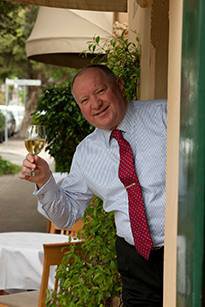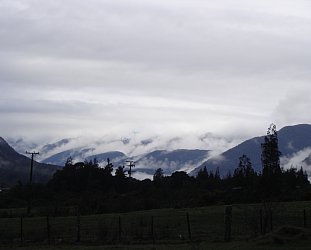Graham Reid | | 2 min read

What constitutes a great restaurant?
Not just superb food . . . but the atmosphere, surely?
Lucio's Italian in Sydney (see their website here) has won me every time on both counts (and interesting wine from Lucio's region of Liguria) and I've written about it before as a travel story (here).
It's also like an art gallery-cum-restaurant, or
vice-versa.
So when the wonderfully hospitable Lucio shares a recipe, you take notice . . . and you make it by carefully following the instructions. If Lucio say it's made this way, then it is.
Enjoy, and now we let Lucio himself take over . . .
This recipe is not just pasta with
sauce – it’s a meal in itself, because you cook the vegetables
with the pasta. It’s as vegetarian as anybody could ask.
Ingredients
400g trenette pasta (or linguine if you can’t find them)
300 g green beans put through a stringer, or sliced on the diagonal
1 potato (large and waxy), peeled and diced into 2cm cubes
1 knob butter
For the sauce
50 small fresh basil leaves
1 clove garlic peeled
pinch sea salt
2 tablespoons grated parmesan cheese
1 tablespoon mild grated pecorino (Sardinian is best)
1 tablespoon raw pine nuts
60 ml extra virgin oil or as much as required to give the right consistency
Method
Start by making the sauce. Carefully wash the basil leaves and dry them gently between two paper towels without pressure.
If you want to use the mortar, begin by putting in the garlic with a pinch of salt (this will help to keep the basil green). Crush the garlic, then add the basil leaves and continue pounding against the wall of the mortar with a rotary movement, not just beating against the bottom of the mortar.
Add the pine nuts, the two cheeses and a tablespoon of oil and continue mixing with the pestle. When the mixture is reduced to a creamy consistency, transfer it to a clean container, add a little more oil and mix with a wooden spoon. Pour on more oil to cover the pesto. If you are keeping the sauce for a while, make sure it is always covered with olive oil to maintain the colour and stop it from going black.
If you prefer to use a blender, put all ingredients in at once and use the lowest speed. Stop often to let it to cool down, because hot oil will affect the aroma of the basil. Pulse until it reaches the desired consistency. Set the sauce aside.
Bring a large pot of water to the boil. Add salt. Throw in the potatoes. After five minutes, throw in the beans and the pasta. When the pasta is al dente (should be about 7 minutes), strain the pasta, beans and potatoes, reserving some of the cooking water.
Place 2 tbsp of pesto sauce in a large bowl with two tablespoons of the reserved water. Add the pasta, beans and potatoes and a knob of butter and toss well to spread the sauce. Put another tbsp of pesto on top, and a sprinkle of parmesan, and serve.
Remember that pesto is a sauce used only ‘a crudo’, that is not cooked, so when you add it to the pasta it must be done off the heat.
Serve immediately.





post a comment